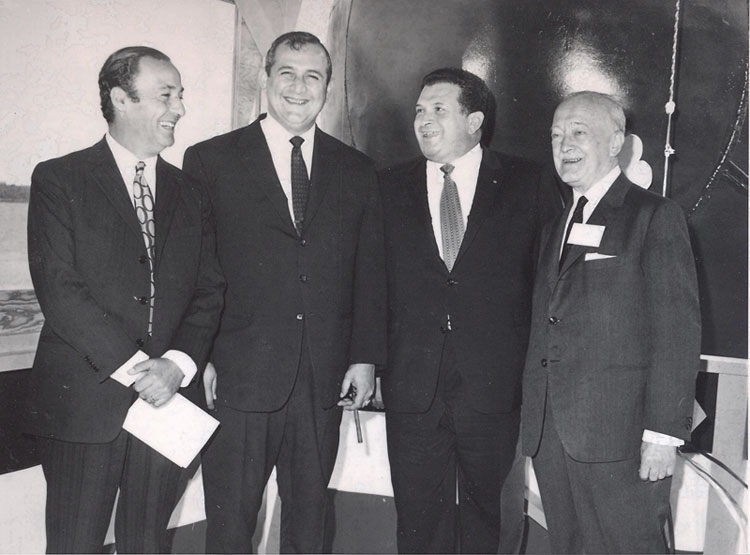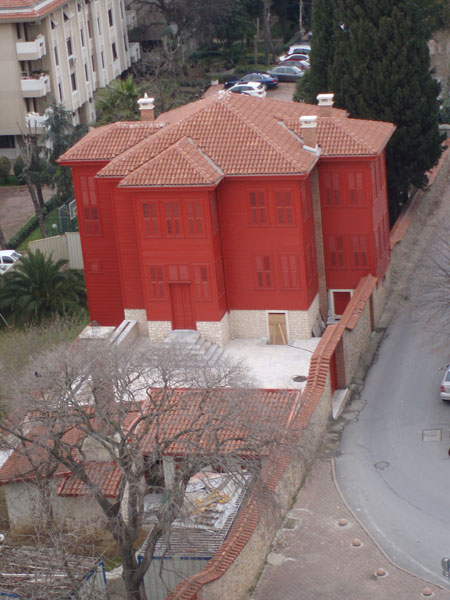Gabriel Couteaux family of Fenerbahçe, Istanbul - Osman Öndeş
There stands today a wooden building painted red ochre standing in the neighbourhood of Fenerbahçe, Asiatic Istanbul once belonged to the well-known Belgian merchant and shipping agent Gabriel Couteaux. Later the konak and the land around was sold off and while the house has been preserved the extensive grounds now house around 20 apartment blocks.
Gabriel Couteaux was a highly active businessman. The Couteaux family had escaped from Tsarist Russia with the revolutionary turmoil there post WWI. In 1926 with together with the businessmen İzzet Akosman, Afif Tektaş and Willi Marguery he helped establish the Turkish Belgian Trade Association. In addition for a period he was the president of the committee of the Artigiana Care Home for the elderly, based in Harbiye, Istanbul, that was established on the 16th March 1838 by an Italian from Trieste, Giacomo Anderlich.
Gabriel Couteaux owned a Han in Galata, named Couteaux han that stood adjacent to the passenger waiting room on Karaköy Pier, a site now occupied by a bank. He was at the same time the honorary consul of Belgium, was highly cultured and could read and write in 9 languages including Russian. Gabriel Couteaux was a well-known and important shipping agent at the time, representing amongst others American President Line, Japan Osaka Line, Messagerie Maritime, Paquet, Fabre Line and Prudential Line. In addition to this Gabriel Couteaux for a time, after WWI period, was partners with the Istanbul ship-owner Laurent Reboul. One of the ships that was later owned by Couteaux that went through a lot of owners: in 1893 the Snowflake was launched from its yard at Newcastle Upon Tyne, England, in a later sale in 1913 was renamed Kremlin, on sale again it was renamed Vellĝy, sold again in 1925 to the Norwegian company Bryde & Dahls Hvalfangerselskap A/S and renamed Thorĝy. In April 1940 he saw moved to England to escape the German invasion of that country, used by Britain in the trans-Atlantic convoys, escaping U-Boats, damaged by a German air attack in January 1941, but repaired. On 8 April 1947 the ship was sold to the Laurent Reboul & Gabriel Couteaux partnership and renamed Anne de France.
Gabriel Couteaux was a respected executive member of both the Belgium and the British Chambers of Commerce in Istanbul. In addition he was one of the founder members of the Chambre Maritime Des Compagnies de Navigation Etrangéres in 1902.
Remi Marinçiç worked for the Gabriel Couteaux firm, rising to become the manager of the agency. He was born in the Anatolian city of Eskişehir, whose father was a Croatian engineer who spent 25 years in the Eastern Anatolian town of Nusaybin - Karkamış.
Gabriel Couteaux chose his place of residence in Fenerbahçe as opposed to the British preferred location of Moda also on the Asian side of Istanbul. At the time Fenerbahçe was farmlands and today the house stands across the Fenerbahçe Mosque, with the street infront leading onto Kalamış Marina. In the early years of his residence he took his private horse carriage to Kadıköy from whence he would take a boat to the Karaköy. In later years with regular services by the Şirketi Hayriye company calling at Moda and Fenerbahçe allowed for direct transportation to and from work. On Sundays with other Christians of the neighbourhood he would go to church and on fine days do local excursions. After his death his daughter moved to France but would visit Istanbul regularly, a city she missed.
Note: In addition to his roles in the Chambers of Commerce and shipping agency, Gabriel Couteaux was involved with Unilever in producing soap using his own resourcefulness to get around trade restrictions in Turkey at the time as detailed in the book: Unilever Overseas: The Anatomy of a Multinational, 1895-1965, p. 436: Unilever could never obtain a licence under [Turkish] Law 6224 to manufacture laundry soap or NSDs [non-soap detergent] and remit the profits. It has been seen that the concern received permission under this law in June 1950 to make margarine and vegetable ghee. In 1954 a licence was also granted to make a toilet soap and scouring powder, but critically this did not include laundry soaps or NSDs. At the same time this did not seem to matter much because Unilever was preoccupied with the early stages of the margarine and vegetable ghee enterprise and they therefore used their licence to make toilet soap and Vim on a small scale in conjunction with a small local manufacturer called Couteaux whose business will be described below... p. 440: The Second World War was really responsible for Couteauxs eventual position as a local partner with Unilever in a manufacturing enterprise. Until 1939 Vim had been mixed and packed at the Unilever oil mill at Bakırköy but during the war Unilever could no longer deliver raw materials to Istanbul and this gave Couteaux the idea of making Vim out of local materials. He and two Turkish employees searched until they found silex on the shores of the Black Sea. He got millstones to grind the silex and faced them which granite to keep the powder as white as possible. In a short time he was manufacturing Vim à façon and paying royalties. But other Port Sunlight products were cut off by the war and soap was in short supply in Turkey. Couteaux therefore bought a very old private house in the heart of Istanbul called the Bell House. He converted it to a primitive factory, made his own Bell Soap there, and then obtained permission to make Lux Soap Flakes, again on a royalty basis. After the war he sent his son-in-law [Pascal Serres, who later was the general manager of the toiletry product manufacturer Perfektüp] to Port Sunlight to learn how to boil soap in a Lever manner. By 1951, when (Lord) Geoffrey Heyworth and Sidney Van den Bergh visited Istanbul to take stock of conditions, they found that Couteaux was ambitious to extend his Lever range and make Lux Toilet Soap; and at this point Unilever had seriously to consider future policy. Should they continue to entrust one after another of their premium brands to a small independent firm operating under relatively primitive conditions in old Istanbul or reverse their attack on the Turkish market in the hope that sooner or later they might be in a position to manufacture there on a satisfactory scale?
Heyworth and Van den Bergh seem to have decided to trust their fortunes to Couteaux. Their decision may have been influenced by the fact that at about the same time the Turkish firm Puro, which already sold toothpaste and aspirin, had started to sell toilet soap, and this threat of competition with imported Lux Toilet Soap from within the Turkish import tariff may have induced them to use Couteaux to defend their established market. The only alternative seemed to be to build a Unilever soap factory and, as has been seen, it was by no means certain that the Turkish authorities would give a licence for this. Since the market for toilet soap was small, a Lever factory making only toilet soap would probably not have been viable even if it was permitted... Collaboration with Couteaux had at least given Unilever a toehold in the Turkish soap market at small cost and very little risk.
 |
 |